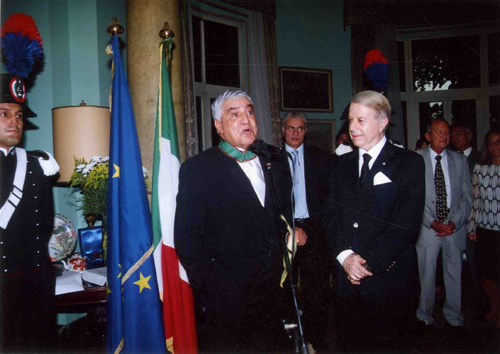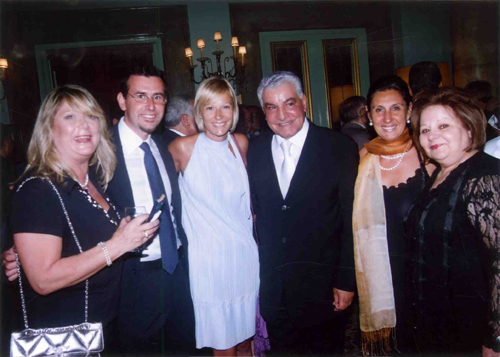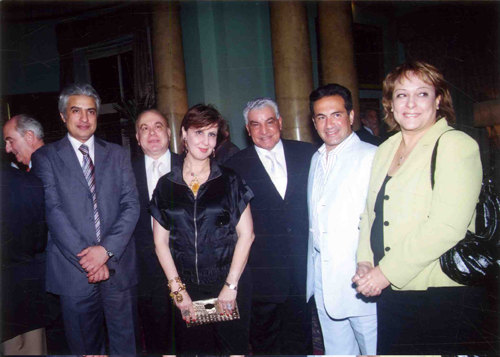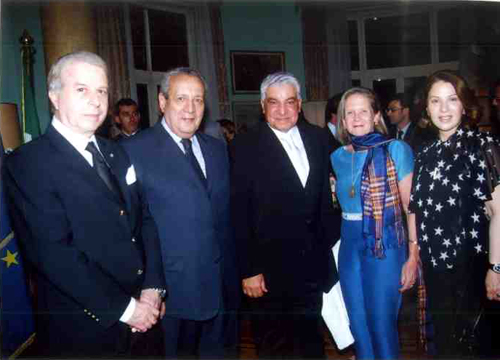|
Prestigious Award from Italy
On June 22, 2008, Dr. Zahi
Hawass was awarded the rank of Commander in the Order of Merit of the
Italian Republic. This honor is conferred in recognition of outstanding
contributions to literature, the economy, public service, and social,
philanthropic and humanitarian activities.
Ambassador Pacifico introduced Dr. Hawass in a speech that highlighted the many remarkable achievements of his career, along with his contributions to the warm cultural relationship between Egypt and Italy. Dr. Hawass himself then charmed guests with his acceptance speech, in which he related a number of stories. He regaled his audience with an account of his first encounter with Italian archaeology, when he was a 20-year-old inspector assigned to the Italian mission led by Sergio Donadoni at Sheikh Ibada. The Italian archaeologists came to Dr. Hawass in a panic after discovering that some of the artifacts from their excavation had been stolen. Dr. Hawass quickly solved the problem by informing the mayor of the local village that he knew where the artifacts had gone and was prepared to take action – the artifacts reappeared at the archaeologists’ camp the next day!
Another story that Dr. Hawass related in his speech was that of his first encounter with the Italian public, a late-night debate at the foot of the Sphinx, which was broadcast on Italy’s Channel 3. The famous journalist Lorenza Foschini hosted the debate between Dr. Hawass and Graham Hancock, Robert Bauval, and John Anthony West. At that time these three men were receiving a lot of attention for their idea that the pyramids and the sphinx had been built 10,000 years ago by the survivors of a lost civilization. Because these three men were so well known, Dr. Hawass was afraid that he would be unable to compete with them in the debate, and so he asked his friend Omar Sherif to join him as a “supporting actor.” The Italians were so thrilled by Sherif’s presence that they listened eagerly to what Dr. Hawass said. Since that time, he has become a fixture on Italian television, and is famous throughout the country.
Dr. Hawass also talked about his many trips to Italy, during which he has visited small towns throughout the country. In the town of Civitanova Marche, there is an elderly man who has a theory about how the stones used in building the pyramids were moved, and Dr. Hawass enjoyed meeting and talking with him. Dr. Hawass visited the museum in Palestrina, which is home to a stela showing the journey of the river Nile from its source, through Egypt, and to the Mediterranean. Dr. Hawass has visited many other cities in Italy, including Latina, Rovereto, Padua, and San Rimo, and in each one, he is always amazed to see how great crowds turn out for his lectures. Truly, ancient Egypt is alive in the hearts of the Italian people. Dr. Hawass also discussed the importance of Turin, the first city abroad to have a museum dedicated entirely to ancient Egypt. Turin is also home to the Association of Friends of Egypt, headed by Stella Mazzanti.
Today, 24 Italian missions are following the long tradition of Italian archaeology in Egypt. Dr. Hawass talked in his speech about how he is connected with this tradition through his work in KV17, the tomb of Seti I, which was discovered in 1817 by Giovanni Belzoni. Belzoni was the first to enter a deep tunnel that descends from the burial chamber – Dr. Hawass’s team has now excavated this tunnel to a depth of 136.5 meters, and found many objects such as shabtis and blocks inscribed with the name of Seti I, perhaps indicating that something exciting lies at the end. Dr. Hawass also mentioned Caviglia’s discovery of the 16% of the beard of the Sphinx - 3% of the beard is now in the British Museum, while the remaining 13% found by Caviglia is in the Egyptian Museum, Cairo. He went on to mention Barzanti, who used cement to restore ancient monuments, and is now jokingly referred to as “Bar-cement-i.” He also talked about the discovery in 1904 of the tomb of Nefertari by Ernesto Schiaparelli, and the restoration of this tomb, often called “the most beautiful tomb in Egypt,” by Paulo Mora.
Hawass also raised the
subject of two vital cooperative projects between Italy and Egypt- the
development of a new scenario for the Egyptian Museum Cairo, and the risk
map of Saqqara and the Faiyum. He praised the “Year of Italian-Egyptian
Culture” for showing the vital importance of cultural exchange and
cooperation between the two countries, and strengthening their already
vital relationship. He declared that Italy is one of only a few countries
in the world that truly has his whole heart.
|





